- Joined
- Sep 23, 2012
- Messages
- 716
So, I've considered making this post for a while. I see a lot of people keeping tortoises that are a real challenge in their home climate, and I've been down that road as well. Over time I have realized fighting against my local climate is hard and have put a lot of effort into considering which tortoises are best for the climate here. And, in my case, I'm talking the southeast US. The main reason for posting this is because I felt the information might have value to others, and because there's a lot of really terrible information and advice out there about what climates are appropriate for what tortoises. So please, consider digging deeper when deciding what tortoise you want, especially if you plan to keep it outside.
First, there are a lot of systems used to classify climate. I'll consider one of the more popular ones which is the Koppen-Geiger classification. Here's a world map using that classification:
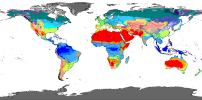
Next, let's look just at the humid subtropical climate zones cfa and cwa. The cfa zone has no dry season, and cwa has a winter dry season. I will predominantly focus on the cfa zone. Note this map is from a different website and they defined the zones slightly differently.
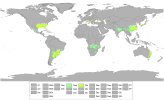
So the question is, what tortoises either live in cfa climates (like the southeast US), or very close to them geographically. The gopher tortoise obviously lives in the southeast already, but it's protected. There were also two other native tortoises in South Carolina before humans arrived, but they're both extinct. Here is the climate data for Augusta, GA, which is the closest city to me. Temps range from 32F to 92F (typical highs & lows) with about 3-4" of rain a month year round. This is typical of inland piedmont or coastal plains regions of Georgia and South Carolina.

At first glance there are two very large regions of cfa other than in the US. The first is china (and Japan). Unfortunately no tortoises live here presently - there was once a manouria species that did, but it's long extinct. The next largest region is in South America, and as it happens, Chaco tortoises live along the drier portion of this cfa region, which includes the humid Chaco (they also inhabit the dry chaco, which is classified as semi-arid). Here's a comparison of the historical chaco totoise range versus the humid subtropical region:
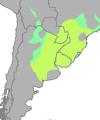
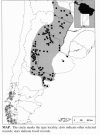
Now, let's look at some cities in the Chaco tortoise range:
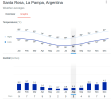
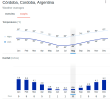
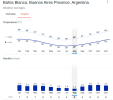
Note that Cordoba is just over the line (climate wise), having a dry winter it's not technically cfa, but it's quite close. Overall we see about 35-89F. Summer rainfall is about 3-5.5" per month, and winter rainfall is lower at 0.5-1.5" per month. So temperature wise, a great match to Augusta, but with a little less rain in the winter. Note that summer temperatures are actually COOLER than Augusta, and the warm season rainfall is not desert-like at all.
The next largest cfa region on the map is in Australia, which unfortunately has no tortoises. So after that, it's Europe - specifically regions just north of the Mediterranean: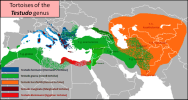

Both Hermann's tortoises (eastern and western) and greek tortoises live within the cfa regions in this part of Europe (Russian and Marginated tortoises live very close nearby). All of these species are good candidates. Looking at some city data:
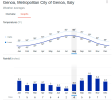
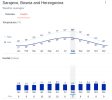

Most of this area is fairly rural, and lacking in climate data. Genoa and Sochi are both coastal, while Sarajevo is inland. Summer high temps are around 82F typical in all locations, but winter low temps are very cold inland (27F in Sarajevo) and milder near water (38-42F). All regions have rainfall year round, 2-7" typically. There is significant overlap between the ranges of Hermann's and Ibera greek tortoises, and both species should be able to survive winters in the southeastern US given that they experience harsher conditions in their native ranges. The warmer summer temperatures in the southeast US are unlikely to be a problem.
The last cfa region worth discussing is so small on the world map that it's easy to miss: South Africa.
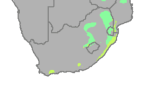
While the area that is cfa is quite small, leopard tortoises (and angulated tortoises) live in these areas, even though much of their range is too dry to qualify as cfa (it's semi-arid, like the dryer portions of the Chaco tortoise range). Let's compare some cities:

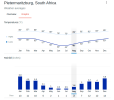
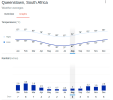

Note first that Durban is within the South Africa cfa region, and the South African leopard tortoises in the US are thought to have originally been from this area. I also include Pietermaritzburg, which is slightly inland of Durban, to consider what temperatures are like with less coastal influence (leopard tortoises inhabit both areas). Queenstown and Stutterheim are not cfa (being just slightly too dry) but are not far off in climate and are home to both leopard and angulated tortoises. Overall, we have a temperature range of about 37F-87F with rainfall of 2-6" per month in summer and about 0.5-1.5" in winter. This situation is very similar to that of Chaco tortoises in that winters are slightly warmer and dryer, but summer conditions are very similar to the southeastern US.
So based on all of the above, the tortoises I feel could best adapt to the climate here are:
Hermann's tortoise
Greek tortoise (T.g. ibera or anamurensis)
Chaco tortoise
Leopard tortoise (only genetics from South Africa)
Marginated tortoise
Angulated tortoise
Russian tortoise
(in roughly decreasing order of climate similarity)
I am of course ignoring the native gopherus since we generally can't keep those, and all the other South African tortoises (which aren't obtainable).
Hope this was an interesting exercise for folks.
-Steve
First, there are a lot of systems used to classify climate. I'll consider one of the more popular ones which is the Koppen-Geiger classification. Here's a world map using that classification:

Next, let's look just at the humid subtropical climate zones cfa and cwa. The cfa zone has no dry season, and cwa has a winter dry season. I will predominantly focus on the cfa zone. Note this map is from a different website and they defined the zones slightly differently.

So the question is, what tortoises either live in cfa climates (like the southeast US), or very close to them geographically. The gopher tortoise obviously lives in the southeast already, but it's protected. There were also two other native tortoises in South Carolina before humans arrived, but they're both extinct. Here is the climate data for Augusta, GA, which is the closest city to me. Temps range from 32F to 92F (typical highs & lows) with about 3-4" of rain a month year round. This is typical of inland piedmont or coastal plains regions of Georgia and South Carolina.

At first glance there are two very large regions of cfa other than in the US. The first is china (and Japan). Unfortunately no tortoises live here presently - there was once a manouria species that did, but it's long extinct. The next largest region is in South America, and as it happens, Chaco tortoises live along the drier portion of this cfa region, which includes the humid Chaco (they also inhabit the dry chaco, which is classified as semi-arid). Here's a comparison of the historical chaco totoise range versus the humid subtropical region:


Now, let's look at some cities in the Chaco tortoise range:



Note that Cordoba is just over the line (climate wise), having a dry winter it's not technically cfa, but it's quite close. Overall we see about 35-89F. Summer rainfall is about 3-5.5" per month, and winter rainfall is lower at 0.5-1.5" per month. So temperature wise, a great match to Augusta, but with a little less rain in the winter. Note that summer temperatures are actually COOLER than Augusta, and the warm season rainfall is not desert-like at all.
The next largest cfa region on the map is in Australia, which unfortunately has no tortoises. So after that, it's Europe - specifically regions just north of the Mediterranean:


Both Hermann's tortoises (eastern and western) and greek tortoises live within the cfa regions in this part of Europe (Russian and Marginated tortoises live very close nearby). All of these species are good candidates. Looking at some city data:



Most of this area is fairly rural, and lacking in climate data. Genoa and Sochi are both coastal, while Sarajevo is inland. Summer high temps are around 82F typical in all locations, but winter low temps are very cold inland (27F in Sarajevo) and milder near water (38-42F). All regions have rainfall year round, 2-7" typically. There is significant overlap between the ranges of Hermann's and Ibera greek tortoises, and both species should be able to survive winters in the southeastern US given that they experience harsher conditions in their native ranges. The warmer summer temperatures in the southeast US are unlikely to be a problem.
The last cfa region worth discussing is so small on the world map that it's easy to miss: South Africa.

While the area that is cfa is quite small, leopard tortoises (and angulated tortoises) live in these areas, even though much of their range is too dry to qualify as cfa (it's semi-arid, like the dryer portions of the Chaco tortoise range). Let's compare some cities:




Note first that Durban is within the South Africa cfa region, and the South African leopard tortoises in the US are thought to have originally been from this area. I also include Pietermaritzburg, which is slightly inland of Durban, to consider what temperatures are like with less coastal influence (leopard tortoises inhabit both areas). Queenstown and Stutterheim are not cfa (being just slightly too dry) but are not far off in climate and are home to both leopard and angulated tortoises. Overall, we have a temperature range of about 37F-87F with rainfall of 2-6" per month in summer and about 0.5-1.5" in winter. This situation is very similar to that of Chaco tortoises in that winters are slightly warmer and dryer, but summer conditions are very similar to the southeastern US.
So based on all of the above, the tortoises I feel could best adapt to the climate here are:
Hermann's tortoise
Greek tortoise (T.g. ibera or anamurensis)
Chaco tortoise
Leopard tortoise (only genetics from South Africa)
Marginated tortoise
Angulated tortoise
Russian tortoise
(in roughly decreasing order of climate similarity)
I am of course ignoring the native gopherus since we generally can't keep those, and all the other South African tortoises (which aren't obtainable).
Hope this was an interesting exercise for folks.
-Steve